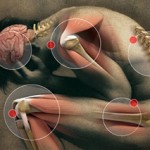Postural Distortion: Imbalance in the muscular tonus system resulting in the movement of the body off the coronal (front to back) and mid-saggital (side to side) planes.
Laws of Physiology
Law of Facilitation -(path of least resistance)
Davis’ Law– If muscle ends are brought closer together, then the pull of tonus is increased, thereby shortening the muscle which may even cause hypertrophy. If muscle ends are separated beyond normal, then tonus is lessened or lost, thereby weakening (stressing) the muscle
Hilton’ Law– A nerve trunk which supplies a joint also supplies the muscles of the joint and skin over the insertions such muscles.
Arndt- Shultz Law-Weak stimuli activate physiological processes. Very strong stimuli inhibit them.
 Pfluger’s Laws
Pfluger’s Laws
Law of Unilaterality– If a mild irritation is applied to one or more sensory nerves, movement will take place usually on one side only-the side which is irritated.
Law of Symmetry– If the stimulation is sufficiently increased; motor reaction is manifested not only by the irritated side, but also in similar muscles on the opposite side of the body.
Law of Radiation– If the excitation continues to increase, it is propagated upward and reactions take place through centrifugal nerves coming from the cord segments higher up.
Law of Generalization– When the irritation becomes very intense, it is propagated in the medulla oblongata which becomes a focus from which stimuli radiate to all parts of the cord. This causes a general contraction of all muscles in the body.
Neurological laws that also explain how the central nervous system initiates and maintains pain, the goal is to help relieve the pain and dysfunction by understanding and alleviating the underlying cause.
